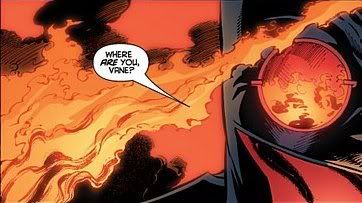More of Hell's Mirrors: Jog swings down on his silken cord for 12/28
/![]() For the record, my experiment in reading only Grant Morrison's bits of the recent The Resurrection of Ra's al Ghul Bat-crossover wound up reconfirming that Morrison can write some decent, undemanding Big Superhero action - something I probably didn't need reconfirmed, but it wasn't unpleasant or anything. It seemed a bit like a constrained JLA.
For the record, my experiment in reading only Grant Morrison's bits of the recent The Resurrection of Ra's al Ghul Bat-crossover wound up reconfirming that Morrison can write some decent, undemanding Big Superhero action - something I probably didn't need reconfirmed, but it wasn't unpleasant or anything. It seemed a bit like a constrained JLA.
Batman #672: As for post-crossover accessibility, this issue pretty much picks the story up from where it left off pre-Ra's (and pre-J.H. Williams III, for that matter), although there's always the chance that Morrison might string everything together later on. Or he's already subtly playing off of events in comics I haven't read. Certainly for me this run is already past the point where looking through prior issues feels like you're reading entirely new comics, due to the writer's foreshadowing and thematic play suddenly becoming clearer.
It's a technique Morrison generally pulls off with panache, although I suspect it might be working a bit stronger here since the actual stories he's been telling have been so thin. This issue is no more supple: a bombastic, quintessentially Morrisonian opening leads into some bland character work and a flurry of action and dramatic pronouncements that serve to both poke at things we already know and string out mysteries a little longer, the issue ending in a small jump forward. It might have stood out better with more distinctive art, but Tony Daniel and a squad of inkers is what we've got.

And don't forget the allusions - as Geoff Klock points out, the issue is also chock-full of nods toward prior Batman stories, especially Frank Miller's. It's all really starting to remind me of New X-Men in its notion of the hero(es) struggling to move beyond set ways yet being confronted with the same old issues (cleaning up the colorful baddies only to find more dirty cops, more political corruption), with the prospect of an awful future acting as the ultimate result of present-day discouragement. But while Batman #666 was much more fun (and a lot shorter) than Here Comes Tomorrow, the 'awful future' was a cleaner fit in the earlier work, since it doubles as a familiar X-Men trope itself.
Here, Morrison also sets up Batman's conflict as a doppelgänger of the challenges facing another major DC hero in the concurrently-running All Star Superman, with lots of troubled alternate versions of Our Hero running around. But most of these are demonic, dark Batmen, threatening to drag the real deal down into the muck and establish a most extreme '90s-style future; is it any wonder that Batman must set aside his street-level instincts and call on the likes of Bat-Mite for help? Is it all a critique of the grimmer side of the character? Might changes in the present be used to counteract the awful future? Will Jean once again give the cosmic wink so Scott can kiss Emma with his tongue, guilt-free, thus saving us all?

We'll only know in time. But unlike a lot of Morrison's longform superhero works, this run doesn't function very well as the series of stories it's nominally constructed as. Instead, it frustratingly seems to start and stops its long plot with breaks for things like an illustrated prose issue, a tepid (if visually rich) mystery and a line-wide crossover. Some of these detours do have thematic links to the main plot, and they may tie in more directly later, but none of them have been strong enough individually to alleviate the feelings of distraction and mild haste that have come to permeate the run; for once, the superhero serial form seems to be working against the writer. Makes for some EH chapters while waiting for the big picture to become clearer, although promise remains.











